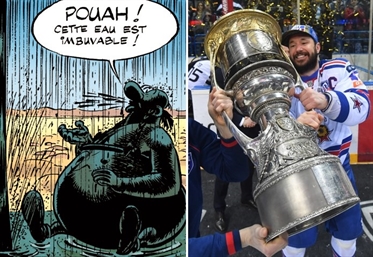Asterix: The Hockey Way
Asterix: The Hockey Way
Rise of the KHL with “Black Gold”

 Like Asterix and Obelix finding “Black Gold” in the desert, Russia’s oil-financed KHL exploded on to the scene in 2008. Photos: Editions Albert René, Alexei Kudenko / RIA Novosti
Like Asterix and Obelix finding “Black Gold” in the desert, Russia’s oil-financed KHL exploded on to the scene in 2008. Photos: Editions Albert René, Alexei Kudenko / RIA Novosti
Leading up to the 2017 IIHF Ice Hockey World Championship, we’re dedicating one article to each day of the tournament, making a tongue-in-cheek comparison between an Asterix comic book and famous aspects of international hockey history.
Some teams at the Worlds will be heavily stocked with talent from the Kontinental Hockey League – think of the Russia-Latvia clash on 15 May in Cologne. That’s a great time to revisit the oily roots of that league!
The KHL brought high aspirations as the successor to the old Russian Superliga. It offered higher salaries, better-run clubs, and new arenas to lure not only Russian stars but also more talent from other hockey powers. And just as the village druid Getafix reveals in Asterix and the Black Gold that oil is an essential ingredient for his magic potion, likewise the KHL couldn’t have taken off without oil and gas!
For example, Alexander Medvedev, the deputy chairman of the Russian energy company Gazprom, served as the president of the KHL from 2008 to 2014. He also headed up perennial powerhouse SKA St. Petersburg, and represented Russia on the IIHF Council from 2008 to 2012. The classic CSKA Moscow franchise was purchased by Rosneft, the state-owned oil company. “Neft”, the Russian word for oil, can also be found in club names such as Neftekhimik Nizhnekamsk or in sponsor names of many teams.
Despite being based in Russia, this league has become an international showcase. Similar to how Asterix and Obelix bump into Assyrians, Hittites, and Medes in a Middle Eastern desert, fans at KHL arenas can see 29 clubs from eight countries, including Belarus, China, Croatia, Finland, Kazakhstan, Latvia, Russia, and Slovakia!
In the Asterix book, a fly carries a message to the head of Caesar’s secret service and lands in his soup. And while NHL fans originally feared the KHL would siphon off barrels of talent, the outflow proved to be more of a fly-in-a-soup-like annoyance. Although loaded with skilled players, the league has typically done best at attracting older NHL legends such as Jaromir Jagr, Sergei Fyodorov and Pavel Datsyuk. (These are also known as “fossil fuels.”) Top scorers like Ilya Kovalchuk and Alexander Radulov have been exceptions to the rule, but Radulov returned to North America to shine with the Montreal Canadiens this season.
Like the bees that chase honey-covered Roman villains, hockey players tend to chase the money. The drop in oil prices since 2014 has seen more KHL-trained Russians heading to the NHL, from Chicago’s Artemi Panarin to Washington’s Yevgeni Kuznetsov to Toronto’s Nikita Zaitsev. However, there may be a reprieve for KHL fans. Although Getafix discovers that beetroot juice can be substituted for oil in his recipe, smart hockey observers know there’s no substitute for the Olympics, and some Russian stars will likely stay in the KHL next season to improve their chances of competing in South Korea in February!
This is a 17-part series prior to the 2017 IIHF Ice Hockey World Championship, of which Asterix and Obelix are the official mascots. Click on News to find the stories.
Back to Overview
































































































